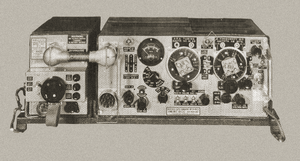Wireless Set No. 19

The Wireless Set No. 19 was a Second World War mobile radio transceiver designed for use by armoured troops of the British Army.
Specifications
The set was designed to allow HF communication between tanks.
Mk II and Mk III complete - 27 × 10 × 13.25 in (68.6 × 25.4 × 33.7 cm)
Sender/receiver - 17.5 × 8.25 × 12.25 in (44.5 × 21.0 × 31.1 cm); supply unit - 6 × 8.25 × 12.5 in (15.2 × 21.0 × 31.8 cm)
- Weight:
Mk II complete - 86.25 lb (39.12 kg)[1]
Sender/receiver - 40.5 lb (18.4 kg); supply unit - 28.5 lb (12.9 kg); carrier no. 1 - 14.75 lb (6.69 kg)
Mk III complete - 88.25 lb (40.03 kg)[2]
Sender/receiver - 40.5 lb (18.4 kg); supply unit - 30.5 lb (13.8 kg); carrier no. 1 - 14.75 lb (6.69 kg)
- Frequency range: 'A' setting 2–8 MHz; 'B' setting 229–241 MHz. Master Oscillator controlled.
- Modes: AM, MCW, CW.
- VHF inter-tank communications
- Crew intercom
- Single dial receive and transmit tuning
- "Flick" switch for rapid frequency change
- RF output: 'A' setting 2.5–9 watts.
- Range: 'A' set 10 miles (16 km); 'B' set 1,000 yards (910 m) (between moving vehicles).[1]
History

The Wireless Set No. 19 was developed in 1940 by the British War Office's Signals Experimental Establishment and by Pye Radio. The Pye model was replaced with the MK II model in 1941, and the MK III model in 1942. The sets proved valuable for armoured fighting in the Western Desert.
In 1942, the No. 19 Mk II was produced in Canada by Northern Electric Co., Canadian Marconi Co. and RCA Victor. The British design was improved and interchangeability of components such as the valves, was instituted.[3] A majority of Canadian sets used English/Cyrillic front panel lettering, the result of a Lend-Lease contract to the Soviet Red Army.[4]
Post-war, forward area battle group radio traffic carried by Wireless Set No. 19 nets was progressively migrated to low-band VHF using a more modern generation of radios known as the New Range, later to become known as Larkspur. This employed FM and replaced the No. 19 in this role from 1954. As a result the No. 19's VHF 'B' section was abandoned and removed when sets were overhauled. The Royal Armoured Corps No. 19 sets were mostly replaced in the mid-1950s with a militarized version of the PYE PTC-202 known as the C12 as an interim measure, which were subsequently replaced with the C13 from 1960.[5] An additional RF amplifier for the No. 19 (Amplifier, RF No. 2) increased the daylight operational range up to about 45 miles (72 km). The experimental Wireless Set No. 19 TH (built for the Dutch Army) featured increased frequency coverage up to 12 MHz.
Post-war, the Canadian No. 19 MK II and III was used in the Swedish and Italian Army, and some Canadian No. 19 MK III sets were used by the British Army.
The No. 19 Mk III in a simplified configuration was still on issue to British cadet units as an operational training station as late as the mid-1970s.
Today the Wireless Set No. 19 is collected, restored and operated by vintage amateur radio enthusiasts.[5][6]
See also
Notes
- ↑ 1.0 1.1 1.2 "The WS#19 MK II Manual". QSL.net. Retrieved 20 June 2013.
- ↑ 2.0 2.1 "The Wireless Set (Canadian) No. 19 M III Working Instructions". QSL.net. Retrieved 20 June 2013.
- ↑ Bisaillion, Chris. "The 19 Set -- A History". QSL.net. Retrieved 20 January 2012.
- ↑ "Wireless Set No.19 Mk III (Mk 3)". RadioMuseum.org. Retrieved 20 January 2012.
- ↑ 5.0 5.1 "Wireless Set No 19". Royal Signals Museum. Archived from the original on 9 June 2007.
- ↑ "Wireless Set No. 19". Vintage and Military Amateur Radio Society. Retrieved 20 January 2012.
External links
- The Original Wireless Set No. 19 Group
- Wireless Set No. 19 documentation archive at Royalsignals.org.uk